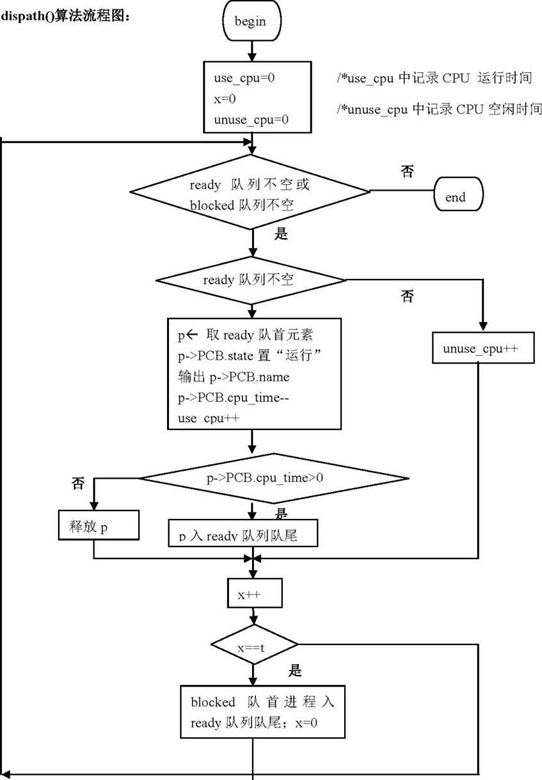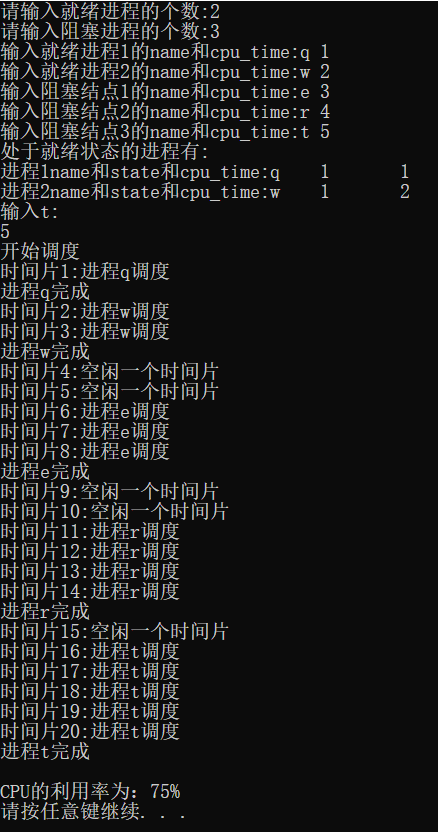实验一进程调度
实验性质:设计
建议学时:6学时
实验目的:
通过这次实验,加深对进程概念的理解,进一步掌握进程状态的转变、进程调度的策略及对系统 性能的评价方法。
实验内容;
设计程序模拟进程的轮转法调度过程。假设初始状态为:有n个进程处于就绪状态,有m个进 程处于阻塞状态。釆用轮转法进程调度算法进行调度。调度过程中,假设处于执行状态的进程不会阻 塞,且每过t个时间片系统释放资源,唤醒处于阻塞队列队首的进程。
程序要求如下:
1) 输出系统中进程的调度次序;
2) 计算CPU利用率。
实现提示:
用C语言实现提示:
1) 程序中进程可用PCB表示,其类型描述如下:
struct PCB_type {
char name ; 〃进程名
int state ; //进程状态
2 表示“执行"状态
1——表示“就绪”状态
0——表示“阻塞”状态
int cpu_time ; 〃运行需要的CPU时间(需运行的时间片个数)
}
2) 设置两个队列,将处于“就绪”状态的进程PCB挂在队列ready中;将处于“阻塞”状态的 进程PCB挂在队列blocked中。队列类型描述如下:
struct QueueNode{
struct PCB_type PCB;
Struct QueueNode *next;
}
并设全程量:
struct QueueNode ready_head=NULL, //ready队列队首指针
*ready_tail=NULL, //ready队列队尾指针
*blocked_head=NULL, //blocked队列队首指针
*blocked_tail=NULL; //blocked队列队尾指针
3)设计子程序
start_stateO; 〃读入假设的数据,设置系统初始状态
dispathO; 〃模拟调度
calculate。; //计算 CPU 利用率
实验要求:
1) 上机前仔细编好程序;
2) 上机时独立调试程序;
3) 提交实验报告,包括纸质稿和电子稿两部分。实验报告要求详见实验报告模板。
测试用数据:
n=2 (处于就绪状态的进程的个数)
m=3 (处于阻塞状态的进程的个数)
t=5 (每过t个时间片系统释放资源,唤醒处于阻塞队列队首的进程)


测试用例:

代码展示
#include <iostream>
#include <fstream>
using namespace std;
struct PCB_type
{
char name;
/* 0:阻塞 1:就绪 2:执行 */
int state;
/* 需要的CPU时间,即运行的时间片个数 */
double cpu_time;
};
struct QueueNode
{
PCB_type PCB;
QueueNode *next;
};
QueueNode *ready_head = NULL,
*ready_tail = NULL,
*blocked_head = NULL,
*blocked_tail = NULL;
int all_time = 0;
int free_time = 0;
double time_slice_len = 1;
// 函数声明
void start_state();
void dispath();
void calculate();
void ready_Enqueue(QueueNode *p);
void blocked_Enqueue(QueueNode *p);
void ready_Dequeue();
void blocked_Dequeue();
QueueNode *ready_Front();
QueueNode *blocked_Front();
int main()
{
start_state();
dispath();
calculate();
system("pause");
return 0;
}
void start_state()
{
ifstream f;
f.open("OS\\test1.txt");
int ready_pcb_num, blocked_pcb_num;
f >> ready_pcb_num;
f >> blocked_pcb_num;
// 就绪队列初始化
for (int i = 0; i < ready_pcb_num; i++)
{
QueueNode *p = new QueueNode;
f >> p->PCB.name >> p->PCB.cpu_time;
p->PCB.state = 1;
p->next = NULL;
ready_Enqueue(p);
}
// 阻塞队列初始化
for (int i = 0; i < blocked_pcb_num; i++)
{
QueueNode *p = new QueueNode;
f >> p->PCB.name >> p->PCB.cpu_time;
p->PCB.state = 0;
p->next = NULL;
blocked_Enqueue(p);
}
cout << "The processes in the ready queue are:" << endl;
if (ready_head == NULL)
{
cout << "The ready queue is empty";
}
else
{
QueueNode *p = ready_head;
while (p)
{
cout << p->PCB.name << " " << p->PCB.state << " " << p->PCB.cpu_time << endl;
p = p->next;
}
}
// 输入t
int t;
f >> t;
}
void dispath()
{
cout << "Start scheduling" << endl;
while (ready_head != NULL || blocked_head != NULL)
{
if (ready_head != NULL)
{
QueueNode *tmp = ready_Front();
ready_Dequeue();
tmp->PCB.state = 2;
tmp->PCB.cpu_time -= time_slice_len;
all_time++;
printf("Time slice %d: process %c scheduling\n", all_time, tmp->PCB.name);
if (tmp->PCB.cpu_time < time_slice_len)
{
printf("process %c over!\n", tmp->PCB.name);
}
else
{
ready_Enqueue(tmp);
}
}
else
{
all_time++;
free_time++;
printf("Time slice %d: Free a slice of time\n", all_time);
}
if (blocked_head != NULL && all_time % 5 == 0)
{
QueueNode *tmp = blocked_Front();
blocked_Dequeue();
ready_Enqueue(tmp);
}
}
}
void calculate()
{
cout << "CPU Utilization rate: " << ((all_time - free_time) / (double)all_time) * 100 << "%" << endl;
}
// 队列实现
void ready_Enqueue(QueueNode *p)
{
if (ready_head == NULL)
{
ready_head = ready_tail = p;
}
else
{
ready_tail->next = p;
ready_tail = p;
}
}
void blocked_Enqueue(QueueNode *p)
{
if (blocked_head == NULL)
{
blocked_head = blocked_tail = p;
}
else
{
blocked_tail->next = p;
blocked_tail = p;
}
}
void ready_Dequeue()
{
QueueNode *temp = ready_head;
if (ready_head == NULL)
{
printf("ready Queue is Empty\n");
return;
}
if (ready_head == ready_tail)
{
ready_head = ready_tail = NULL;
}
else
{
ready_head = ready_head->next;
}
}
void blocked_Dequeue()
{
QueueNode *temp = blocked_head;
if (blocked_head == NULL)
{
printf("blocked Queue is Empty\n");
return;
}
if (blocked_head == blocked_tail)
{
blocked_head = blocked_tail = NULL;
}
else
{
blocked_head = blocked_head->next;
}
}
QueueNode *ready_Front()
{
return ready_head;
}
QueueNode *blocked_Front()
{
return blocked_head;
}